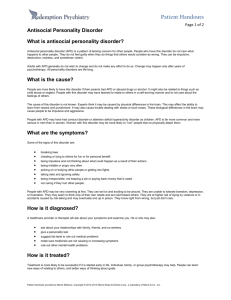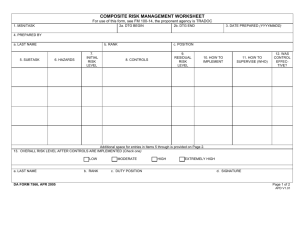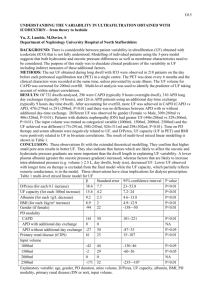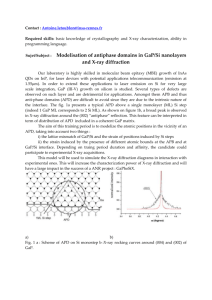File
advertisement
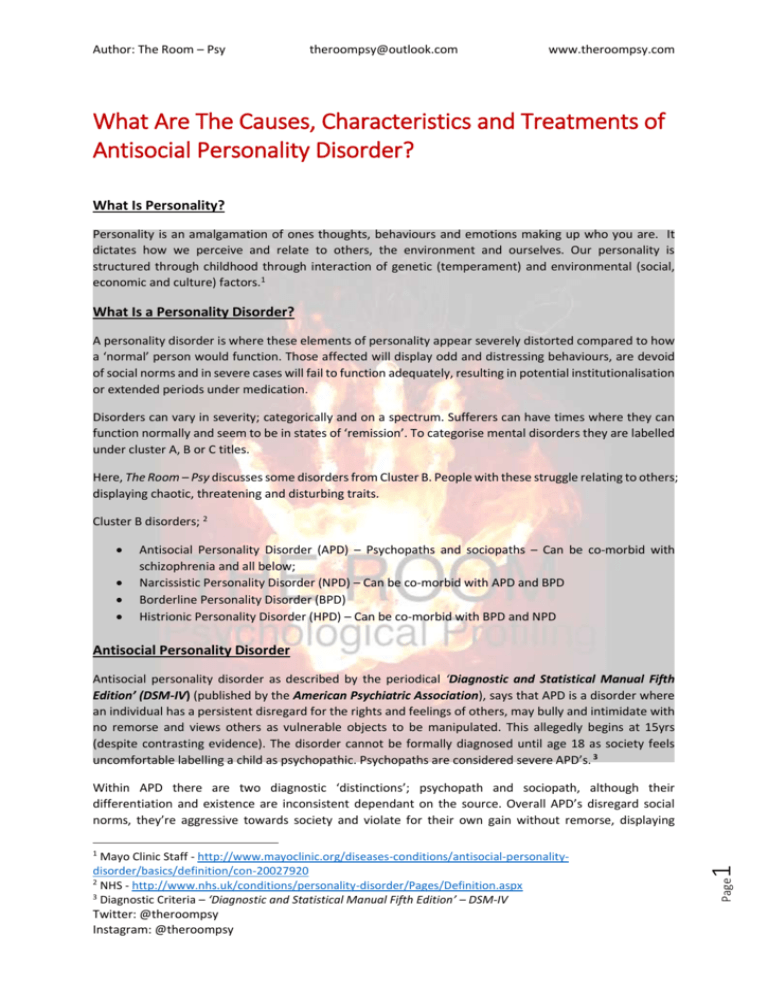
Author: The Room – Psy theroompsy@outlook.com www.theroompsy.com What Are The Causes, Characteristics and Treatments of Antisocial Personality Disorder? What Is Personality? Personality is an amalgamation of ones thoughts, behaviours and emotions making up who you are. It dictates how we perceive and relate to others, the environment and ourselves. Our personality is structured through childhood through interaction of genetic (temperament) and environmental (social, economic and culture) factors.1 What Is a Personality Disorder? A personality disorder is where these elements of personality appear severely distorted compared to how a ‘normal’ person would function. Those affected will display odd and distressing behaviours, are devoid of social norms and in severe cases will fail to function adequately, resulting in potential institutionalisation or extended periods under medication. Disorders can vary in severity; categorically and on a spectrum. Sufferers can have times where they can function normally and seem to be in states of ‘remission’. To categorise mental disorders they are labelled under cluster A, B or C titles. Here, The Room – Psy discusses some disorders from Cluster B. People with these struggle relating to others; displaying chaotic, threatening and disturbing traits. Cluster B disorders; 2 Antisocial Personality Disorder (APD) – Psychopaths and sociopaths – Can be co-morbid with schizophrenia and all below; Narcissistic Personality Disorder (NPD) – Can be co-morbid with APD and BPD Borderline Personality Disorder (BPD) Histrionic Personality Disorder (HPD) – Can be co-morbid with BPD and NPD Antisocial Personality Disorder Antisocial personality disorder as described by the periodical ‘Diagnostic and Statistical Manual Fifth Edition’ (DSM-IV) (published by the American Psychiatric Association), says that APD is a disorder where an individual has a persistent disregard for the rights and feelings of others, may bully and intimidate with no remorse and views others as vulnerable objects to be manipulated. This allegedly begins at 15yrs (despite contrasting evidence). The disorder cannot be formally diagnosed until age 18 as society feels uncomfortable labelling a child as psychopathic. Psychopaths are considered severe APD’s. 3 Within APD there are two diagnostic ‘distinctions’; psychopath and sociopath, although their differentiation and existence are inconsistent dependant on the source. Overall APD’s disregard social norms, they’re aggressive towards society and violate for their own gain without remorse, displaying Twitter: @theroompsy Instagram: @theroompsy Page Mayo Clinic Staff - http://www.mayoclinic.org/diseases-conditions/antisocial-personalitydisorder/basics/definition/con-20027920 2 NHS - http://www.nhs.uk/conditions/personality-disorder/Pages/Definition.aspx 3 Diagnostic Criteria – ‘Diagnostic and Statistical Manual Fifth Edition’ – DSM-IV 1 1 Author: The Room – Psy theroompsy@outlook.com www.theroompsy.com indifference when reprimanded. This behaviour is continuous, they have no conscience, moral compass or empathy and so are able to behave ruthlessly and objectively to victims. They also engage in criminal behaviours, from repeated minor offences to violent killings. Although not exhaustive, the following list summarises some of the symptoms of APD. To be diagnosed, at least 3 of the following must be present (preferably with a history of behavioural issues as a child such as diagnosis of conduct disorder; • • • • • • • Behaviour that could be grounds for arrest such as theft or assault Deceitful and manipulative Inability to plan ahead High levels of aggression Endangers others Inability to hold a stable job or relationships Lack of remorse4 APD is a term often used interchangeable with psychopath and sociopath, both consisting of their own characteristics, debated causes and treatments. These terms are inconsistent between diagnostic manuals, mental health and law professionals. Some suggest they are distinct from each other, others claim they are the same, while some suggest only slight differences.5 Those that say they are distinct; could it be due to APD being on a spectrum? Or that psychos and socios are actually two different afflictions while overlapping some symptoms? The evidence is unclear and so the two are summarised under ‘Antisocial Personality Disorder’: E.g The World Health Organisation’s periodical diagnostic manual namely the ‘International Statistical Classification of Diseases Tenth Edition’ (ICD-10)6 labels the same disorder as dissocial personality disorder within it, acknowledging both the terms psychopath and sociopath. Whereas the DSM-IV doesn’t mention the term ‘sociopath’ and has more stringent criteria to qualify for a diagnosis then the ICD. Also, while both manuals don’t outline a spectrum of the disorder, a psychologist does; Theodore Millon7 outlines his theory of 5 sub-types of APD (containing schizoid, histrionic and narcissistic co-morbidity) and a further 10 which include overlapping elements of the original 5. Demographics and other sources explain that although many psychopaths have similarities to that consistent with APD, most of those diagnosed with APD are not psychopaths. This is because psychopathy is considered a stringent subpopulation of APD of less than 1%. 8 “Recent estimates say 1%-4% of the population, or 1 in every 25 people, is a sociopath – that’s higher than the percentage of people who have anorexia or autism.” – M.E Thomas9 4 Ibid 3 Book – ‘Thinking About Psychopaths and Psychopathy’ – Edited by Ellsworth Lapham Fersch 6 Diagnostic Criteria - International Statistical Classification of Diseases Tenth Edition’ - ICD-10 7 Theodore Millon Theory - http://en.wikipedia.org/wiki/Antisocial_personality_disorder 8 Book – ‘Confessions of a Sociopath’ – M.E Thomas 9 Ibid 8 Twitter: @theroompsy Instagram: @theroompsy Page 2 5 Author: The Room – Psy theroompsy@outlook.com www.theroompsy.com So what do some people say the differences are between psychopath and sociopath and are they important? Psychopath Vs Sociopath They’re distinguished by their characteristics, how they’re influenced by nature vs nurture and the professionals’ personal preference. ‘Sociopath’ tends to be a term used by sociologists and criminologists, claiming its cause is nurture; their environment and upbringing. Whereas psychopath tends to be a term used by clinicians who explain the phenomena as a cause of nature; biology and genetics.10 The behavioural differences suggest that sociopaths are highly disorganised and impulsive and struggle to hold consistent jobs and relationships. Sociopaths don’t feel empathy although they can form bonds (albeit limited) to those who have context to their lives e.g. Family members and friends. However, only if they provide a benefit e.g. a tangible gain, sex, companionship, entertainment.11 ‘Friendships aren’t anything SociopathWorld.com12 more than a series of mutually beneficial exchanges…’ – Sociopaths can make decisions not to direct their violations towards people they ‘care’ about, whereas psychopaths will abuse family just as fast as they would a stranger. Sociopaths have poor anger control and are incredibly sensitive to becoming enraged. The psychopath does not, they remain cool and coy with little reaction and maintain this even in extreme situations. They are unnerving, logical and methodological thinkers. This observation is reflected in the nature of their crimes; sociopathic crimes are spontaneous and disorganised whereas a psychopaths are intelligently planned with close attention to detail.13 Supposedly psychopaths are born with a brain defect responsible for emotion and impulse, while a sociopath most likely suffered abuse or negative environments growing up. There is little evidence to support this however.14 E.g: J.F.W. Deakin of University of Manchester's Neuroscience and Psychiatry Unit 15 discusses that psychopathy is due to low cerebrospinal fluid concentrations of 5-HIAA (a serotonin metaboliser) which has been observed to cause low mood functioning, a feature seen in APD’s. This research is supported by findings from Brown et al (1994)16 as published in their Journal of ‘Offender Rehabilitation’. They noted that low serotonin levels were correlated with impulsiveness and aggression across many different experimental paradigms conducted. These are features also associated with APD. However Robert Hare17 (who created one the diagnostic criterias for APD used today) explains APD may be caused by environmental factors as reports in the United States suggests links to changes in cultural mores. Others such as Sutker et al18 in ‘APD Comprehensive Handbook of Psychopathology Volume III (2002)’ discusses that APD is due to a by-product of the widening employ (and abuse) of diagnostic techniques. Overall, the Twitter: @theroompsy Instagram: @theroompsy Page Informational & support website on mind control, psychopaths, narcissists & help for victims - David Mc Dermott - http://www.decision-making-confidence.com/sociopath-vs-psychopath.html **************&* 11 Ibid 8 12 Website – Online community of sociopaths, victims and others run by sociopath law teacher M.E Thomas and author of ‘Confessions of a Sociopath’ - http://www.sociopathworld.com/ 13 Ibid 10 14 Ibid 10 15 Ibid 7 16 Ibid 7 17 Ibid 5 18 Ibid 7 3 10 Author: The Room – Psy theroompsy@outlook.com www.theroompsy.com majority of evidence suggests it is likely to be not just caused but influenced by a range of biological and psychosocial factors. Psychosocial factors can arise as follows; Child trauma can cause cognitive defence mechanisms to initiate, irreparably deforming how individuals think and relate. It impairs their ability to empathise and desensitises them to disturbing or immoral situations, eliminating their ability to have a normal perception of, or reaction to stimuli. It also means they will be more likely to engage in questionable behaviours and won’t feel that it’s wrong as they wouldn’t have developed a moral compass. Between 0-4yrs we learn empathy and begin attaching feeling to meaning. When a toddler see’s their parent distressed, they may offer them something they’re holding (e.g toy/food) in an attempt to comfort as they learnt the item previously had comforted them.19 (This learning is called operant conditioning – forming an association with a behaviour and a result). If the toddler views the behaviour as successful, they will repeat it - the basics of learning empathy and attachment. However, this theory it isn’t measureable as it’s impossible to establish if the infant understands the emotion at that age or if they’re merely distressed by the adult’s behaviour and responding to it. During these years, the brain develops neural and cognitive abilities. If deprived of developmental input or receives negative input from a parent during these crucial stages, then those basic skills (e.g. attachment and empathy) will fail to be learnt; later to be expressed as symptoms of APD. These children may display ruthless disturbing behaviour such as violence, cruelty to animals and starting fires. The starting points suggesting that a psychopathic, socially feared monster is brewing. (E.g Beth Thomas – ‘A Child of Rage’ Documentary)20 ‘I am functionally a good person and yet I am not motivated or constrained by the same things that most good people are. Am I a monster? I prefer to believe that you and I simply occupy different points on the spectrum of humanity.’ – M.E Thomas21 Characteristics People with APD are glib, witty, charming, callous, sexually promiscuous and can be flexible with acting homosexually. They have a poor sense of self with no true character; absorbing and mirroring personalities and emotions they observe and adopting them as their own. They establish peoples likes, dislikes, vulnerabilities and feed off them simulating their absolute soulmate and kindred spirit. They have an accurate and superior understanding of how others think and so play into every fantasy and insecurity namely the ‘love bombing’ and ‘idolisation phase’22. Their aim is to make themselves as appealing to their ‘target’ as possible through imitating their ideal partner. This reflects the APD’s parasitic lifestyle, living off others, making them as emotionally dependent as possible. Eventually they’ll discard the individual and move on; they’re drifters leaving a trail of broken hearts and ruins in their wake. With an overinflated sense of entitlement to the world, they deceive and manipulate without guilt or remorse. Early signs can be observed during childhood E.g. James Bulger murder victim. Thompson and Venables - children who abducted and murdered.23 Twitter: @theroompsy Instagram: @theroompsy Page Website – PsychCentral - largest and oldest independent award-winning mental health social network run by mental health professionals http://psychcentral.com/lib/how-children-develop-empathy/0001234 20 Child psychopath interview – Beth Thomas – ‘A Child of Rage Documentary’ https://www.youtube.com/watch?v=g2-Re_Fl_L4 21 Ibid 8 22 Ibid 5 23 Real life case – Psychopathic child murders - James Bulger murder - Thompson and Venables http://en.wikipedia.org/wiki/Murder_of_James_Bulger 4 19 Author: The Room – Psy theroompsy@outlook.com www.theroompsy.com They have no inhibitions and therefore can effortlessly make unbreakable eye-contact that many say is uncomfortable or alluring. This is where psychopaths were coined with having the ‘predatory, dead eyed stare’.24 Remembering how psychopaths enjoy controlling and manipulating, it is of no surprise that they’re often situated in positions of power. “Sometimes a situation warrants kindness, other times cruelty. Neither situation makes me feel a particular way.” – SociopathWorld.com25 Politicians, the famous, CEO’s, doctors, lawyers, therapists etc. have huge amounts of power. These types of vocation lends themselves to complement the natural traits of a psychopath with some professions directly seeking those with such traits! It’s therefore not surprising that these careers are often populated by such! E.g. Tom Retterbush released an article: “It’s Official: Obama Diagnosed with Narcissistic & Sociopathic Personality Disorders by World Leading Experts”. 26 But how reliable is Retterbush’s article? Dr. Sam Vaknin,27 NPD expert also suggested the likelihood of this in a clinical interview in 2010. People in such positions as Obama need to be able to take charge, make ruthless smart decisions and get people to willingly bend to demands. These are direct skills of a psychopath; practiced control, domineering and manipulation. Another example is Vladimir Putin, the Russian president. Speculation of his personality being sociopathic has cropped up in many recent psychological analyses, while others have speculated Asperger’s.28 Much of his ruthless behaviour and grossly distorted thinking (e.g invasion of the Crimea and other political adventurisms), has led conspiracists and the psychological community to size up his personality type. Although observations suggest signs of a character disturbance, interpreting political behaviour in psychological terms always involves a risk. It is also difficult to establish whether behaviour displayed has been due to a long-standing behavioural pattern (and so politics lent itself as an appealing vocation for someone of his character), or whether the position itself - with the by-product of having absolute power made him impervious to the concern of risk, rendering him highly egocentric, narcissistic and devoid of self-awareness. Does the nature of his position enforce him to see others as objects, or has this always been his rationale? The debate has snowballed raising curiosity and conspiracy through the roof, however nothing official has yet been established.29 “Whatever their personal boundaries are, people can always be made to compromise them” – SocipoathWorld.com30 Twitter: @theroompsy Instagram: @theroompsy Page Informational & support website on mind control, psychopaths, narcissists & help for victims - David Mc Dermott - http://www.decision-making-confidence.com/definition-of-psychopath.html 25 Ibid 12 26 Article - Tom Retterbush - http://conspiracy-watch.org/obama-diagnosed-narcissistic-sociopathicpersonality-disorders/ 27 Supporting interview analysis on Obama – Dr Sam Vaknin - http://moralmatters.org/2014/01/06/obamasnarcissism-explained-by-dr-sam-vaknin-the-author-of-malignant-self-love-a-must-hear-interview/ 28 Website - Putin speculation - https://www.psychologytoday.com/blog/the-winner-effect/201403/thedanger-lurks-inside-vladimir-putins-brain 29 Website – Putin speculation – Asperger’s, sociopathic or not? - http://www.theguardian.com/science/headquarters/2015/feb/07/putin-aspergers-story-stupidity-of-psychological-diagnosis-from-a-distance 30 Ibid 12 5 24 Author: The Room – Psy theroompsy@outlook.com www.theroompsy.com Causes The causes of APD have been heavily debated as the precise cause isn’t known. The question is whether it’s a result of nature, nurture or an interaction of both. Evidence supporting a biological influence are outlined by studies finding that criminality may be genetically determined, regardless of enviro-social influence (Lomborso 1876 31 ). This could be drawn parallel as a similarity to explain APD’s aggressive and impulsive nature. Studies supporting this have also identified that emotional loss in psychopaths could be due to damage/deformity of the amygdala32 in the brain which could have occurred by genetic mutation or a result of prenatal or perinatal insults. Studies such as Lombroso’s can also be criticised that evidence is inconsistent and also that they were mostly correlational studies testing the relationship between two variables, therefore cannot establish the cause and effect). This genetic explanation could possibly support the aggression/characteristics of an APD. Others such as M.E Thomas (law teacher and sociopath, author of ‘Confessions of a Sociopath’) discusses her personality type; saying she never experienced any abuse and had a ‘pretty normal life’ yet has this distinct character disturbance which is also reflected in her siblings and on her father’s side of her family, this evidence suggests that APD may be biological.33 This however is a highly unsatisfactory explanation that isn’t directly testable nor measureable. This is because findings, biology and behaviours are inconsistent between families and APD’s studied and so it cannot alone be a reliable explanation. Many psychological explanations such as cognitive, behavioural, learning and psychodynamic approaches would disagree with this also as they too have adequate explanations about the causes, with supporting evidence! Therefore it’s reductionist to regard biology as the definitive explanation as it ignores the role of social, cultural and economic factors. It also poses a question about free will vs determinism. If behaviour is restricted to being a result of biology, it leaves no room for free will and so is incredibly deterministic – implying that their ‘fate’ is theoretically set to be antisocial. Therefore, it is more likely to be caused by a combination of genetic and environmental factors. E.g. people with a genetic vulnerability for a disorder may ‘initiate’ its development when experiencing trauma or certain events. In contrast if someone with the same vulnerability to APD grows up in a supportive, positive environment, they may never go on to develop it. 34 New research into epigenetics explains this propensity versus initiation. 35 Considering epigenetics as an explanation, we can then define personality disorders as a maladaptive syndrome created by person-environment interaction. Maladaptation is the failure to carry out adaptive processes (e.g. in this case, failure to be empathetic) which was caused by biogenetic dispositions or pathological environments or both. Therefore assuming both have an effect, it could mean that the development of a personality disorder is dependent on neurobiological (innate) and adaptive (interactive) etiological factors interacting. The diathesis-stress model is another approach which takes the theory of epigenetics into account. Mealey’s ‘sociopathy model’ discusses how the diathesis-stress model can explain the occurrence of APD 35 Research into Epigenetics - http://www.ncbi.nlm.nih.gov/pubmed/20562740 Twitter: @theroompsy Instagram: @theroompsy Page Psychological study into genetic influences upon criminality – Lomborso http://www.psychlotron.org.uk/newresources/criminological/a2_aqb_crim_physiologicaltheories.pdf 32 Website - Amygdala influence - http://www.bbc.co.uk/news/magazine-31714853 33 Ibid 8 34 Book – ‘Evolutionary Psychiatry. A New Beginning – Second Edition’ – Anthony Stevens and John Price. 6 31 Author: The Room – Psy theroompsy@outlook.com www.theroompsy.com behaviours36. The diathesis-stress model is an approach that incorporates both bio and environmental factors together in one explanation. This model in terms of APD explains genetic and other biovulnerabilities (diathesis) and how they interact with external stimulation (stress) and that this interaction can produce antisocial and other damaging behaviours. 37 Epigenetics, diathesis-stress model and other integrative approaches are much more satisfactory explanations as it takes all factors into account. Although there is no proven cause, there has been some risk factors identified to increase the chances: Diagnosis of conduct disorder at a young age Family history of APD, other personality disorders and mental illness Subjected to abuse Unstable/ chaotic home History of substance abuse in relatives Demographics have identified that men are more effected then women38. They are also much more likely to abuse alcohol and drugs with a high risk of accidental self-injury. This is self-injury a common ‘hallmark’ across all sociopaths as they are unable to learn from their past mistakes. This as a by-product means they are naturally reckless and have no fear concept, thus often resulting in repeatedly hurting themselves. E.g M.E Thomas discusses how she banned herself from using knives as she psychologically couldn’t bring herself to be careful with them (e.g when cooking) and so her hands are covered in scars. The sociopath cannot learn like that and so cannot for-see harm that they may cause.39 Diagnosis If someone’s suspected of having APD and seeks diagnosis, a number of medical and psychological tests will be run. There are multiple tests because sometimes it’s hard to link symptoms to a specific disorder as some symptoms overlap or are co-morbid with other disorders (E.g. NPD and psychopathy, NPD and BPD, schizophrenia and psychopathy or depression). The tests will consist of a physical examination to ensure symptoms aren’t a result of a different problem. Lab tests e.g. blood count, thyroid checks etc., alcohol and drug screening to further check for causes of symptoms. Finally, a psychological evaluation to explore the persons psychological dynamics, how they relate to people and their history. Often people likely to have APD will refuse or will give unreliable reports about themselves and so family and friends may provide this. To diagnose through psychological evaluation Harvey Cleckleys ‘The Mask of Sanity’ is used, outlining 16 traits of a psychopath40. Also available is Robert Hares Psychopathy Checklist, consisting of 20 symptoms of psychopathy which are rated on a scale which will indicate the degree of psychopathy41. Hares checklist 36 Mealey’s ‘sociopathy model’ http://journals.cambridge.org/action/displayAbstract?fromPage=online&aid=6779448&fileId=S0140525X0003 987X 37 Citation from PDF on internet – Book copy - Spence, Richard T., Diana M. DiNitto, and Anthony Walsh. "BIOLOGY AND BEHAVIOR." Twitter: @theroompsy Instagram: @theroompsy Page Ibid 1 Ibid 8 40 Ibid 5 41 Ibid 5 39 7 38 Author: The Room – Psy theroompsy@outlook.com www.theroompsy.com is most commonly used today by professionals as a clinical method to determine whether symptoms are sufficient enough to warrant a psychopathic diagnosis. ‘Robert Hare is quite a heinous researcher, imagine if a cancer researcher spoke about their patients the way he speaks about psychopaths’ – SociopathWorld.com42 Due to the wide disagreement of what makes someone psychopathic etc. it’s important that clinical judgement is based on examination of the persons past and by a direct interview. This helps to avoid misdiagnosis so that correct treatment/ support can be assigned, otherwise it will label the individual with a potential diagnosis that cannot clinically be removed, it will remain on the individuals records forever, the same as schizophrenia would (e.g you can never remove the diagnosis of schizophrenia through recovery, you can only ever be re-assigned as a ‘schizophrenic in remission’. The similar process applies to APD). This can lead to stigmatisation, affecting their ability to get jobs, function in society and may also alter how a criminal case is decided upon.43 Treatment It’s debateable whether APD can be cured or not due to no exact cause being identified. A biological cause can be treated with medication for instance and trauma by various psychotherapies. However, assigning the appropriate treatment (and whether it’s effective) can be hard when the disorder hasn’t been deduced to an exact bio-element in an individual looking for diagnosis and equally baffling if they have the APD characteristics but haven’t had an abusive environment. Some say personality disorders can’t be treated at all, as it’s due to the character of a person, not their mood control such as with mood disorders (depression etc.). This may hold some gravitas with regards to medication remedies, however evidence suggests therapy can help improve behaviour of APD’s over time. The main treatment are psychotherapies – the most popular being Cognitive Behavioural Training (CBT). Although APD is the hardest to treat, it’s also rare that such an individual will willingly seek treatment themselves. Sometimes therapies are enforced by courts44. Psychotherapies Psychotherapies involve speaking with a therapist who aids reflection on personal problems and traumas. It allows the patient to analyse feelings about themselves, others and situations they’ve faced. They’ll attempt to establish what’s caused the issues, equipping the person with solutions. This can involve teaching skills to manage emotions or relationships in a beneficial, non-destructive way and to ‘un-teach’ negative behaviours. Sessions can be one-to-one or with supportive family members. 45 There are many types of psychotherapy; Psychodynamic psychotherapy Cognitive behavioural therapy (CBT) Cognitive analytical therapy (CAT) Interpersonal psychotherapy (IPT) 42 Ibid 12 Ibid 1 44 NHS - http://www.nhs.uk/Conditions/antisocial-personality-disorder/Pages/Introduction.aspx 45 NHS – Guide of psychotherapies http://www.nhs.uk/conditions/psychotherapy/Pages/Introduction.aspx Twitter: @theroompsy Instagram: @theroompsy Page 8 43 Author: The Room – Psy Humanistic therapies Family and marital therapy theroompsy@outlook.com www.theroompsy.com These all have the same aim with different methods to correct ‘faulty thinking’ or negative behaviours, provide coping methods and positive ways to function. These psychotherapy services in the UK are available through the British Association for Counselling and Psychotherapy (BACP) and the UK Council for Psychotherapy (UKCP). Alternatively if medication is decided to be used (as speculated psychopaths as opposed to sociopaths are due to a brain dysfunction. Bio-cause = bio-therapy. Psychological cause = cognitive, learning, behavioural or psychodynamic therapies), antipsychotics and antidepressants may be prescribed. There is no strong evidence to support the effectiveness of this however as success rates are low as stated by the Food and Drug Administration. There is also a risk due to the deceptive nature of the individual that they fake improvement, so reliability reports may lack validity. Carbamazepine and Lithium however manage aggression and impulse control and so may be effective when trying to improve the individual’s anger and so forth other symptoms.46 The National Institute for Health and Care Excellence (NICE)47 provides guidelines for treatment of APD, with respect to the spectrum of the degrees it presents. It’s also encouraged that those who are in close proximity with an APD that they too seek help for themselves. This is so they can gain understanding of how to protect themselves from the aggressive and exploitative nature of the APD, as well as learn skills of coping and how to set boundaries between them and the patient. 46 47 Ibid 44 NICE - Guidelines on treatment - http://www.nice.org.uk/guidance/CG77 Twitter: @theroompsy Instagram: @theroompsy Page 9 As a last resort or in serious cases, if the individual is in breach of the law and/or if the individual is devoid of reason and is dangerous beyond rehabilitation, institutionalisation may be used as an action by force.


